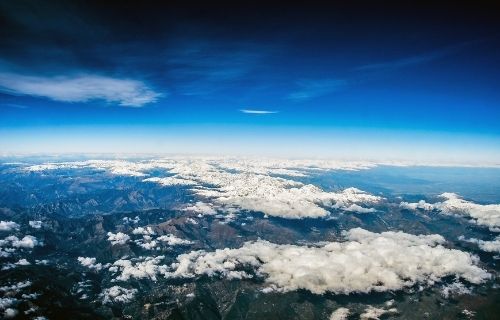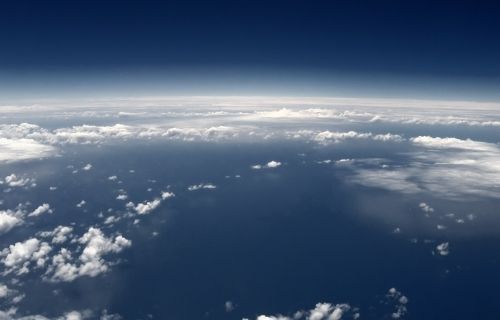Difference Between Troposphere and Stratosphere

Troposphere
The troposphere is the layer of the atmosphere that is closest to Earth’s surface. It extends from the Earth’s surface to an average height of about 10 km. It is the densest part of the atmosphere as well as the part of the atmosphere with the most weather. The top of the troposphere is referred to as the tropopause and its height varies with latitude as well as with the seasons. The tropopause is highest over the equator at about 20 km. It is lowest over the polar regions at about 7 km. It will also be lower during the winter and higher during the summer.
What is the difference between the atmosphere and the troposphere?
The troposphere is part of the atmosphere, but the atmosphere consists of more layers than just the troposphere. There are 5 distinct layers within the atmosphere. The atmosphere refers to the entire envelope of gaseous particles surrounding the planet, extending from the troposphere to the exosphere, the outermost layer of the atmosphere.
What are 3 characteristics of the troposphere?
Temperature gradient
The air in troposphere decreases in temperature with increasing height above the surface. It is for this reason that the highest mountains will have snow even at the equator while there might be rainforests or hot deserts at adjacent lower elevations. At the tropopause, the temperature can get as cold as -55 degrees Celsius.
Weather
The air in the troposphere is continually being warmed by heat radiating from Earth’s surface due to the absorption energy from sunlight. Hot air is less dense than cold air. As a result, the warmer airmasses will displace the colder airmasses above them as the warmer air rises and the colder air sinks to replace the warmer air. This churning of warm and cold airmasses is one of the reasons why the troposphere has the most weather and relatively turbulent air.
Clouds
The troposphere is also the part of the atmosphere with the most moisture. For this reason, most of the clouds in Earth’s atmosphere are in the troposphere.

Stratosphere
The stratosphere is the layer in the atmosphere above the troposphere. It starts at the tropopause at an average of 10 km above Earth’s surface and goes up to about 50 km above the surface. The air in the stratosphere gets warmer with increasing height. For this reason, there is not a lot of turbulence in the stratosphere. Commercial passenger planes will fly in the lower stratosphere partly because the air tends to be calmer than in the troposphere. The top of the stratosphere is called the stratopause.
The ozone layer (O3) is in the stratosphere. Ozone absorbs ultraviolet radiation from the sun and converts it into heat. In this way, ozone also heats up the stratosphere.
Because the air in the stratosphere is fairly calm and stable, due to a lack of vertical convection, dust from volcanic eruptions, or impact events, and industrial pollutants from the troposphere that enter the stratosphere can stay in the stratosphere for long periods of time, from years to centuries. This can lead to a significant change in the global climate.
What are the other layers of the atmosphere?
Above the stratosphere are three more distinct layers, the mesosphere, the thermosphere, and the exosphere.
Mesosphere
The mesosphere is the next layer above the stratosphere. It extends from the stratopause, at about 50 km, up to about 85 km. The air in the mesosphere is very thin compared to the lower atmosphere. The lower mesosphere has below 1% the air pressure at sea level and the air pressure continues to drop off with increasing altitude in within the layer. The mesosphere also witnesses very cold temperatures, as cold as -90 degrees Celsius at the top of the layer. Cosmic material burning up in Earth’s atmosphere tends to become visible in the form of meteors in the mesosphere.
Thermosphere
The thermosphere extends from the top of the mesosphere up to between 500 and 1000 km above Earth’s surface. Many orbiting satellites are in the thermosphere. The temperatures in the thermosphere can get higher than 2000 degrees Celsius, but because the atmosphere is so thin, it has little effect on objects passing through it. The aurora borealis and the aurora australis (the northern lights and the southern lights, respectively) occur in the thermosphere.
Exosphere
Atmospheric scientists disagree about whether the exosphere or the thermosphere represents the maximum extent of Earth’s atmosphere. The “air” in the exosphere is so thin that the environment of the exosphere is hardly distinguishable from that of ambient space. The exosphere has no clear upper boundary, though according to some definitions, it extends out to between 100,000 km and 190,000 km from Earth.
Ionosphere
Unlike the other layers, the ionosphere does not represent a distinct layer, but rather, represents parts of the mesosphere and thermosphere that are dominated by ions. Ions are atoms and molecules which have a net positive or negative charge, often due to being stripped of their electrons, in this case by high energy radiation from the sun. The predominance of ions gives the ionosphere special properties.
What is the hottest layer of the atmosphere?
Based on temperature, the hottest layer in the atmosphere is the thermosphere. The upper thermosphere can reach temperatures higher than 2000 degrees Celsius, though the layer is too thin for these temperatures to affect objects within it.
Similarities between the troposphere and stratosphere
The troposphere and the stratosphere are both part of the lower atmosphere and are both relatively thick compared to the upper atmospheric layers.
Differences between the troposphere and stratosphere
Although there are similarities between the troposphere and the stratosphere, there are also important differences. These differences include the following.
- The temperature gradient in the troposphere decreases with height, whereas the temperature gradient in the stratosphere increases with height.
- The air in the troposphere is continually convecting and overturning due to air being heated by Earth’s surface, whereas the air in the stratosphere is stable and does not convect generally.
- The troposphere has significant clouds, whereas the stratosphere lacks clouds except for nacreous clouds near the poles.
- The troposphere is relatively humid, whereas the stratosphere is relatively dry.
Troposphere vs. stratosphere

Summary
The troposphere is the lowest level of the atmosphere. It extends from Earth’s surface to an average of 10 km in height. The top of the troposphere is called the tropopause. It is highest at the equator at 20 km and lowest at the poles at 7 km. The troposphere contains most of the moisture, most of the weather, and most of the clouds in the atmosphere. The temperature in the troposphere decreases with increasing altitude. The stratosphere is just above the troposphere. It extends from the tropopause to 50 km above Earth’s surface. The top of the stratosphere is called the stratopause. The stratospheric temperature gradient is positive, so that the temperature increases with increasing height above Earth’s surface. Within the stratosphere is the ozone layer. The layers above the stratosphere include the mesosphere, which contains some of the coldest temperatures in the atmosphere, the thermosphere, which contains some of the hottest temperatures in the atmosphere, and the exosphere, which does not have a distinct boundary but fades away into space with increasing distance from Earth. The troposphere and the stratosphere are similar in that they both form the lower atmosphere and are relatively dense compared to the upper atmospheric layers. They differ in important ways as well. The troposphere has a negative temperature gradient, is constantly convecting, has abundant clouds and has abundant moisture. The stratosphere has a positive temperature gradient, has generally stable layers of air, has no clouds, except for at the poles, and is fairly dry.
- Difference Between Environmental Performance Index and Development - November 24, 2023
- Difference Between Environmental Intervention and Development - November 8, 2023
- Difference Between Eco Efficiency and Eco Effectiveness - September 18, 2023
Search DifferenceBetween.net :
Leave a Response
References :
[0]Nalewicki, Jennifer. “The Best Places to See the Southern Lights.” Smithsonian Magazine, 29 Jul. 2017, https://www.smithsonianmag.com/travel/best-places-see-southern-lights-180964246/. Accessed 30 Oct. 2021.
[1]Nalewicki, Jennifer. “The Best Places to See the Southern Lights.” Smithsonian Magazine, 29 Jul. 2017, https://www.smithsonianmag.com/travel/best-places-see-southern-lights-180964246/. Accessed 30 Oct. 2021.
